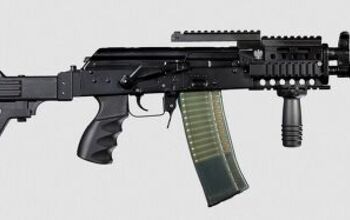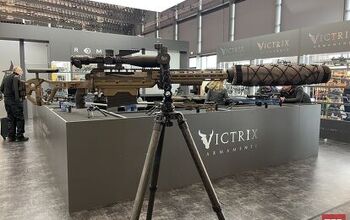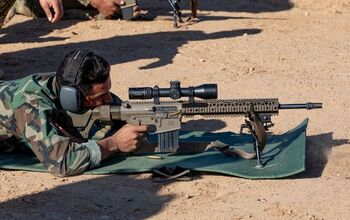US Army Announces Type Classification of Next Generation Squad Weapons

Meet the M7 Rifle and M250 Automatic Rifle, the US Army’s newly type classified infantry small arms. The transition from the XM to fully fledged ‘M’ designations represents “a major program milestone” according to the US Army’s Project Manager Soldier Lethality team who have overseen the selection, refinement and roll-out of the new weapons.
In a short press release Col. Jason Bohannon, Project Manager Soldier Lethality, said: “This milestone reflects our commitment to delivering cutting-edge capabilities that give our Soldiers the tactical advantage and lethality required on the battlefield, we remain focused on equipping our force with the most reliable and effective tools to ensure mission success.”
The M7, formerly the XM7 and for a short time the XM5, will replace the venerable M4 carbine while the M250 will replace the M249 with the US Army’s Close Combat Force. The Close Combat Force is made up of the Army’s frontline fighting units like the 101st Airborne who were amongst the first units to receive the new weapons and have been instrumental in evaluating them and informing their wider issue.
Project Manager Soldier Lethality team noted that “The Type Classification confirms the system meets the Army’s stringent standards for operational performance, safety, and sustainment.” This comes in the face of some recent criticism of the XM7 specifically by a serving US Army Captain in a monograph which highlighted material issues with the rifle and potential limitations brought by the weapon systems’ weight.
In their own press release SIG Sauer explained more about the type classification process:
“The Type Classification affirms the M7 and M250 meet stringent performance, safety, and reliability standards for widespread military use. This designation ensures seamless integration into the U.S. Army’s inventory, streamlining procurement, training, and maintenance across units and asserting the materiel fully satisfies U.S. Army operational needs. This milestone marks the transition of these advanced firearms from developmental to standardized status, signifying readiness for widespread fielding.”
Steve Rose, Executive Vice President, Defense Strategies Group, noted that “This approval underscores the U.S. Army’s commitment to equipping our soldiers with next generation lethality to maintain tactical superiority and enhance mission success. The M7 and M250 represent a transformative leap in combat capability.”
Here at TFB we have closely followed the NGSW program since its launch in 2017, we’ve interviewed both SIG Sauer and the US Army about the program over the years. You can look back through our coverage of the Army’s ambitions program here.
The NGSW program had lofty aims, seeking to adopt a pair of weapon systems which represented a lead ahead in current small arms technology. An ambitious specification calling for increased armor penetration at greater ranges saw SIG’s entries selected following a 27-month prototype phase in April 2022. Since then the XM7 and XM250 have undergone further testing and evaluation, new production lines to produce the weapons’ 6.8x51mm hybrid cased ‘common cartridge’ ammunition have been established and refinements to the weapons have been made.
The type classification of the weapons clears the way for wider adoption of the M7 and M250. At the time of writing there has been no word on the type classification of the NGSW’s ammunition of the advanced XM157 Fire Control optic, which a recent Director, Operational Test and Evaluation report described as ‘as below average/failing’.

Managing Editor: TheFirearmBlog.com & Overt Defense.com. Matt is a British historian specialising in small arms development and military history. He has written several books and for a variety of publications in both the US and UK. Matt is also runs The Armourer's Bench, a video series on historically significant small arms. Here on TFB he covers product and current military small arms news. Reach Matt at: matt@thefirearmblog.com
More by Matthew Moss

















![[SHOT 2025] Bergara's New Rifles For 2025](https://cdn-fastly.thefirearmblog.com/media/2025/01/25/18111/shot-2025-bergara-s-new-rifles-for-2025.jpg?size=350x220)



![[IDEX 2025] The New AK-12/15K and AK-12/15SK Rifles](https://cdn-fastly.thefirearmblog.com/media/2025/02/27/10091/idex-2025-the-new-ak-12-15k-and-ak-12-15sk-rifles.jpg?size=350x220)

![[SHOT 2025] Inland Manufacturing Introduces AM-22 Suppressor](https://cdn-fastly.thefirearmblog.com/media/2025/01/21/23581/shot-2025-inland-manufacturing-introduces-am-22-suppressor.jpg?size=350x220)
Comments
Join the conversation
As someone who is not an expert in any way in military tactics, is it possible that a change from the whole suppressing fire type tactics to a more precision and power based tactic could create a better use case for these new rifles?
Said another way, if we're used to keeping the enemy pinned down with volume of fire, could we accomplish the same with a simple fear of catching a powerful bullet from far away from a quiet and accurate rifle?
And if so, would that change the requirements for carrying as much ammo and all that?
The 6.8x51 round with it's 80,000 (Practice) to 100,000 PSI ball ammo is a completely flawed concept. Heavy recoil, heavy rifles and ammunition and a deafening report and $11,500 optics, $4 a round ammunition is just a non-starter. Both the optics and the rifles are breaking on two-way ranges and in training. The need to penetrate LVL IV armor at 800 meters is a requirement that a desk jockey who plays video games would come up with, not a warfighter. BTW, no warfighters asked for this capability, as it was the perfumed princes in the Pentagon who had "A good idea" that caused us to waste all this time and money. I've handled both of these weapons and the XM7 is just stupid. The XM250 Belt fed has promise, if it's chambered in 7.62x51 NATO and perhaps one day in 6.5 Creedmoor (simple barrel change) which is being adopted by NATO snipers in a couple of countries.